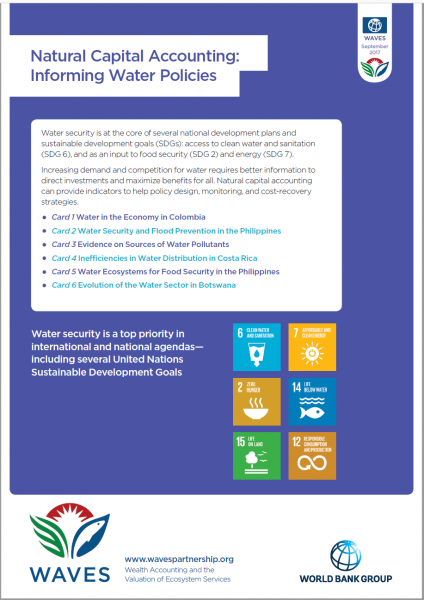The ultimate purpose of natural capital accounts is to guide policymaking. Natural capital accounting (NCA) sheds light on the interactions between natural resources and the economy, and thus illustrates the benefits and trade-offs that come with certain types of economic investments.
This new series, "Natural Capital Accounting and Policy," builds on an earlier series called "NCA in Action" to demonstrate the progress made by five WAVES countries in translating NCA into policy. There are also three thematic briefs on NCA for forests, water, and energy and climate change.
Natural Capital Accounting and Policy: Botswana
Botswana is a middle-income country with fast growth and well-managed resources. It is highly dependent on nonrenewables. National and international actors acknowledge a need to diversify the economy. The country also has high levels of inequality, even though poverty levels have fallen. Degradation of the natural resource base heavily affects those not in formal economies. In particular, water is scarce, and supply is expected to be adversely affected by climate change.
The Government of Botswana led the demand for natural capital accounts. Better data on physical stocks and flows is informing the National Development Plan (2017-22) and various sustainability policies.
Natural Capital Accounting and Policy: Colombia
Colombia is rich in natural resources and is ranked among the highest in the world for water availability. But using resources without reinvesting in them comes at a price: environmental degradation represents losses equivalent to 3.7 percent of the gross domestic product.
Moreover, Colombia is vulnerable to climate change, although the government has made adapatation a central component to the country’s new National Development Plan, whichproposes more sustainable, low-carbon growth and sustainable use of natural capital. It also seeks to achieve resilience and reduce vulnerability to natural disasters.
With WAVES support, Colombia has produced water, land, and timber/forest accounts at the national level; ecosystem accounts at the regional level; and land, water, and expenditure accounts at the watershed level. These accounts make it possible to better assess the real value of natural capital to the economy.
Natural Capital Accounting and Policy: Costa Rica
Costa Rica has made significant investments in conserving its abundant natural resources, with great success.
The country has prepared three main accounts—for forests, water, and energy—using the United Nations System of Environmental-Economic Accounting (SEEA). Results from the first set of accounts will start to reveal the value of natural capital’s contributions to society. This data will help to define the country’s policies into the future.
Natural Capital Accounting and Policy: Indonesia
Natural resources have long played a significant role in Indonesia’s economy. While the country has been keeping track of its energy, mineral, and forest resources since 1997, using the System for Integrated Environmental and Economic Accounting (SISNERLING), it is working to strengthen the system and develop more robust indicators to measure sustainability. Careful attention to how natural resources are used, depleted, and replenished is of paramount importance for national planning.
Natural Capital Accounting and Policy: The Philippines
The Philippines has historically relied on natural capital for its economic growth. In 2010,natural capital accounted for 19 percent of gross domestic product (GDP).
The Philippines is producing mineral, mangrove, and ecosystem accounts. The data generated
will give a clearer picture of the country’s natural capital resources and provide input for
investment and policy decisions.
Natural Capital Accounting: Informing Water Policies
Water security is at the core of several national development plans and sustainable development goals (SDGs): access to clean water and sanitation (SDG 6), and as an input to food security (SDG 2) and energy (SDG 7). Increasing demand and competition for water requires better information to direct investments and maximize benefits for all. Natural capital accounting can provide indicators to help policy design, monitoring, and cost-recovery strategies.
Natural Capital Accounting: Making Forests Count
Forest accounts can help shape good policy on matters ranging from timber extraction to reduction of greenhouse gases. In Colombia, forest accounts have even helped to quantify the environmental impact of the country’s long conflict
and estimate the environmental dividends of peace.
When forest accounts are linked to other natural capital accounts—such as those covering land, water, or energy—they can yield even more detailed data of value to policy makers. For example, understanding the impact of deforestation on an ecosystem’s ability to buffer flooding threats can contribute to better land-use planning.
Natural Capital Accounting: Focusing on Energy and Adapatation to Climate Change
Energy accounts record stocks and flows of energy such as coal, peat, natural gas, oil, and electricity within the economy and show how they are connected to other environmental issues.
Energy accounts are used to link the impact of water on energy production, where there is a significant supply of hydroelectricity. The combination of water and energy accounts can also help identify effective ways to reduce carbon and blue-water footprints.
Energy security is a vital component of adaptation strategies in response to climate change. Energy accounts provide the detail around the generation and consumption of energy—from household to industry level—that can inform sound policy.








